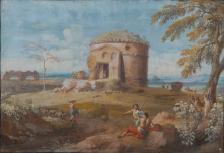View of Tor de Schiavi
The subject
The two temperas, depicting two roman landscapes of Tor de’ Schiavi and the Velabro, are important evidences of the lost city and of the roman countryside completely mortified. The Arch of Janus Quadrifrons, built in the 4th century by order of Costanzo II, rises close to the Temple of Hercules and the Temple of Portunus, in the area of the Velabro, a name derived by the homonymous valley descending from the Roman Forum to the Tiber and frequently flooded. The square-plan building can be identified with the Arcus Constantini, mentioned in the 11th region of the Cataloghi Regionari of the 4th century. In 1830 the arch upper floor and decorative crown were dismounted because considered as not part of the original structure project. In the 7th century, probably on the ruins of a classical-age civil building, the church of Saint Sebastian and Saint George rose, by order of pope Leone II. The church was entirely entitled to Saint George only under the Greek pope Zacharias (741-752) who transferred there the head of the Martyr George, from Cappadocia. The ruins of a Mausoleum, usually defined Tor de’ Schiavi and dated back to the Diocletian’s age (4th century) today are part of the Villa Gordiani Park, located between the 2nd and the 4th kilometer of Via Prenestina. The Villa took its name from an imperial family who built the luxury manor on the ruins of a republic-age ancient construction, between 225 and 244 A.D. The Mausoleum, on two floors, was originally covered by a dome showing seven small cubbies displayed along the circular wall. The ruin was originally composed by a portico with columns and large ascending steps, both today destroyed. The name Tor de’ Schiavi derived from the family of Vincenzo Rossi dello Schiavo, who in 1571 acquired that area, formerly belonged to the Colonna Family, and from there he moved his army to Rome for fighting against Cola di Rienzo.
The painting
In the fundamental book by Andrea Busiri Vici, the life and works of the roman painter Giovanni Battista Busiri is deeply analyzed, including him among the 18th century greatest classic landscape painters, from Locatelli arriving back to Claude Lorrain. Giovan Battista alternatively worked to both real and ideal landscapes, leaving his important contribution to define a genre, started by Van Wittel in the early 18th century, which was practiced by the most important painters during the whole century. The British travelers of the Grand Tour were the most enthusiast about these nice views, real or ideal, by tempera or oil, and they became the most passionate collectors of them. Even today, the English collections are rich of Italian paintings, to represent the main source of study for artists like Batoni, Luti, Locatelli and Busiri himself. At the Fitzwilliam Museum of Cambridge and at the British Museum of London two important albums of drawings by Busiri are preserved; a study of them shows how original was this artist and his skills of capturing symbolic corners of Rome and its countryside. These sketching of basilicas, monasteries, gates, bridges and herbose ruine are executed with clear lines, fresh and quick, marked with a confident style. The tempera and oil landscapes, although they remain faithful to the graphic text, are framed by the artist from a longer distance and are all characterized by a clear sense of depth and prospective. The point of view on the south-west side includes on the left the church of San Giorgio in Velabro, the Arch of Janus Quadrifrons with the top floor made by bricks still there, a group of buildings partially covered of green live oaks. On the foreground a small pond is enriched with a little waterfall and two elegant white swans, while on the edge two men are relaxing under the sun. The theme of the white birds, dear to Busiri as the leafy trees, follows the noble classical landscaping school of Locatelli, Van Bloemen, to Claude Lorrain. The whole representation is enriched with characters who emphasize the monuments: the chariot with cattle and cattleman, probably coming from the nearby Campo Vaccino, are passing close to the arch; two mendicants are begging right in front of the portico of the church; some figures are chatting among them while few others are entering the church. It seems to taste the flavor of daily life typical of Van Wittel’s paintings. Even the light, clear and spread, recalls the Flemish master. An ink on paper sketch depicting a ruin in the roman countryside, bearing on the back the handwritten inscription “Tor de’ Schiavi” is replied in one of the temperas presented here and also in another one preserved in Norwich in the R.W. Ketton-Cremer Esq. Felbrigg Hall collection. This latter reports on the back the inscription “Ancient ruin near Rome called Torre degli Schiavi, suppose to have been a temple of peace. G. B. Busire pinxit, Rome 1740” allowing us to collocate our tempera around that period as well. A theme also used by Hendrik Frans Van Lint in his paintings was the monumental area of Via Prenestina, one of the favorite destinations of Grand Tour travelers in the 18th century. Busiri received the same consideration and fame of his contemporary more famous colleagues; in fact his idea of landscape was retaken by many artists, like the Genoa-born artist Maria Luigia Raggi, as is evident by the study of few panoramic-shaped temperas preserved in the Capitolini Museums in Rome and recently attributed to her. (Consuelo Lollobrigida – May 2012)







